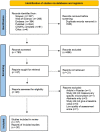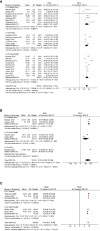The association between micronutrient levels and diabetic foot ulcer: A systematic review with meta-analysis
- PMID: 37065742
- PMCID: PMC10090454
- DOI: 10.3389/fendo.2023.1152854
The association between micronutrient levels and diabetic foot ulcer: A systematic review with meta-analysis
Abstract
Background: Diabetic foot ulcers (DFU) are a major complication of diabetes mellitus (DM). Nutrient deficiencies are among the major risk factors in DFU development and healing. In this context, we aimed to investigate the possible association between micronutrient status and risk of DFU.
Methods: A systematic review (Prospero registration: CRD42021259817) of articles, published in PubMed, Web of Science, Scopus, CINAHL Complete, and Embase, that measured the status of micronutrients in DFU patients was performed.
Results: Thirty-seven studies were considered, of which thirty were included for meta-analysis. These studies reported levels of 11 micronutrients: vitamins B9, B12, C, D, E, calcium, magnesium, iron, selenium, copper, and zinc. DFU, compared to healthy controls (HC) had significantly lower vitamin D (MD: -10.82 14 ng/ml, 95% CI: -20.47, -1.16), magnesium (MD: -0.45 mg/dL, 95% CI: -0.78, -0.12) and selenium (MD: -0.33 µmol/L, 95% CI: -0.34, -0.32) levels. DFU, compared to DM patients without DFU, had significantly lower vitamin D (MD: -5.41 ng/ml, 95% CI: -8.06, -2.76), and magnesium (MD: -0.20 mg/dL, 95% CI: -0.25, -0.15) levels. The overall analysis showed lower levels of vitamin D [15.55ng/ml (95% CI:13.44, 17.65)], vitamin C [4.99µmol/L (95% CI:3.16, 6.83)], magnesium [1.53mg/dL (95% CI:1.28, 1.78)] and selenium [0.54µmol/L (95% CI:0.45, 0.64)].
Conclusion: This review provides evidence that micronutrient levels significantly differ in DFU patients, suggesting an association between micronutrient status and risk of DFU. Therefore, routine monitoring and supplementations are warranted in DFU patients. We suggest that personalized nutrition therapy may be considered in the DFU management guidelines.
Systematic review registration: https://www.crd.york.ac.uk/PROSPERO/display_record.php?RecordID=259817, identifier CRD42021259817.
Keywords: diabetic foot ulcers; micronutrients; minerals; risk; vitamins.
Copyright © 2023 Kurian, Baral, Unnikrishnan, Benson, Munisamy, Saravu, Rodrigues, Rao, Kumar and Miraj.
Conflict of interest statement
The authors declare that the research was conducted in the absence of any commercial or financial relationships that could be construed as a potential conflict of interest.
Figures






References
Publication types
MeSH terms
Substances
LinkOut - more resources
Full Text Sources
Medical

